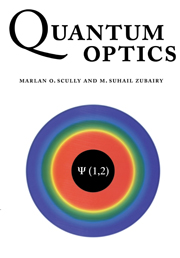Book contents
- Frontmatter
- Contents
- Dedication
- Preface
- 1 Quantum theory of radiation
- 2 Coherent and squeezed states of the radiation field
- 3 Quantum distribution theory and partially coherent radiation
- 4 Field–field and photon–photon interferometry
- 5 Atom–field interaction – semiclassical theory
- 6 Atom–field interaction – quantum theory
- 7 Lasing without inversion and other effects of atomic coherence and interference
- 8 Quantum theory of damping – density operator and wave function approach
- 9 Quantum theory of damping – Heisenberg–Langevin approach
- 10 Resonance fluorescence
- 11 Quantum theory of the laser – density operator approach
- 12 Quantum theory of the laser – Heisenberg–Langevin approach
- 13 Theory of the micromaser
- 14 Correlated emission laser: concept, theory, and analysis
- 15 Phase sensitivity in quantum optical systems: applications
- 16 Squeezing via nonlinear optical processes
- 17 Atom optics
- 18 The EPR paradox, hidden variables, and Bell's theorem
- 19 Quantum nondemolition measurements
- 20 Quantum optical tests of complementarity
- 21 Two-photon interferometry, the quantum measurement problem, and more
- Index
9 - Quantum theory of damping – Heisenberg–Langevin approach
Published online by Cambridge University Press: 05 June 2012
- Frontmatter
- Contents
- Dedication
- Preface
- 1 Quantum theory of radiation
- 2 Coherent and squeezed states of the radiation field
- 3 Quantum distribution theory and partially coherent radiation
- 4 Field–field and photon–photon interferometry
- 5 Atom–field interaction – semiclassical theory
- 6 Atom–field interaction – quantum theory
- 7 Lasing without inversion and other effects of atomic coherence and interference
- 8 Quantum theory of damping – density operator and wave function approach
- 9 Quantum theory of damping – Heisenberg–Langevin approach
- 10 Resonance fluorescence
- 11 Quantum theory of the laser – density operator approach
- 12 Quantum theory of the laser – Heisenberg–Langevin approach
- 13 Theory of the micromaser
- 14 Correlated emission laser: concept, theory, and analysis
- 15 Phase sensitivity in quantum optical systems: applications
- 16 Squeezing via nonlinear optical processes
- 17 Atom optics
- 18 The EPR paradox, hidden variables, and Bell's theorem
- 19 Quantum nondemolition measurements
- 20 Quantum optical tests of complementarity
- 21 Two-photon interferometry, the quantum measurement problem, and more
- Index
Summary
In the previous chapter, we developed the equation of motion for a system as it evolved under the influence of an unobserved (reservoir) system. We used the density matrix approach and worked in the interaction picture. In this chapter, we consider the same problem of the system-reservoir interaction using a quantum operator approach. We again eliminate the reservoir variables. The resulting equations for the system operators include, in addition to the damping terms, the noise operators which produce fluctuations. These equations have the form of classical Langevin equations, which describe, for example, the Brownian motion of a particle suspended in a liquid. The Heisenberg–Langevin approach discussed in this chapter is particularly suitable for the calculation of two-time correlation functions of the system operator as is, for example, required for the determination of the natural linewidth of a laser.
We first consider the damping of the harmonic oscillator by an interaction with a reservoir consisting of many other simple harmonic oscillators. This system describes, for example, the damping of a single-mode field inside a cavity with lossy mirrors. The reservoir, in this case, consists of a large number of phonon-like modes in the mirrors. We also consider the decay of the field due to its interaction with an atomic reservoir. An interesting application of the theory of the system–reservoir interaction is the evolution of an atom inside a damped cavity. It is shown that the spontaneous transition rate of the atom can be substantially enhanced if it is placed in a resonant cavity.
- Type
- Chapter
- Information
- Quantum Optics , pp. 271 - 290Publisher: Cambridge University PressPrint publication year: 1997



